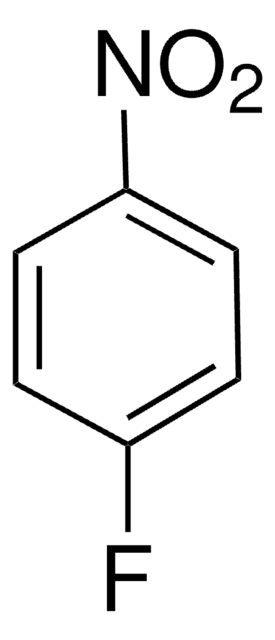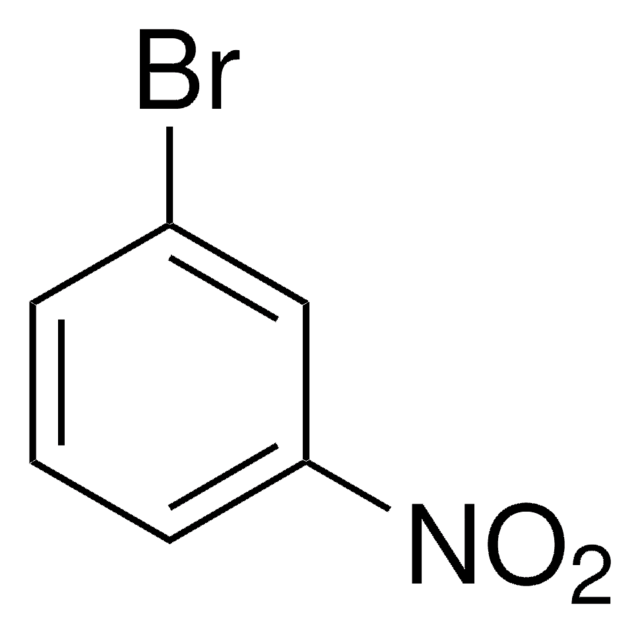推荐产品
蒸汽密度
5.4 (vs air)
蒸汽壓力
0.09 mmHg ( 25 °C)
化驗
99%
形狀
crystals
自燃溫度
500 °F
bp
242 °C (lit.)
mp
80-83 °C (lit.)
密度
1.298 g/mL at 25 °C (lit.)
SMILES 字串
[O-][N+](=O)c1ccc(Cl)cc1
InChI
1S/C6H4ClNO2/c7-5-1-3-6(4-2-5)8(9)10/h1-4H
InChI 密鑰
CZGCEKJOLUNIFY-UHFFFAOYSA-N
正在寻找类似产品? 访问 产品对比指南
訊號詞
Danger
危險分類
Acute Tox. 3 Dermal - Acute Tox. 3 Inhalation - Acute Tox. 3 Oral - Aquatic Chronic 2 - Carc. 2 - Muta. 2 - STOT RE 2
儲存類別代碼
6.1A - Combustible acute toxic Cat. 1 and 2 / very toxic hazardous materials
水污染物質分類(WGK)
WGK 3
閃點(°F)
255.2 °F - closed cup
閃點(°C)
124 °C - closed cup
其他客户在看
Qiang Chen et al.
Chemistry, an Asian journal (2018-05-01)
Platinum nanoparticles encapsulated into zeolite Y (Pt@Y catalyst) exhibit excellent catalytic selectivity in the hydrogenation of substituted nitroarenes to form the corresponding aromatic amines, even after complete conversion. With the hydrogenation of p-chloronitrobenzene as a model, the role of zeolite encapsulation
Ruiyang Qu et al.
Nanomaterials (Basel, Switzerland), 8(9) (2018-09-08)
The solvent-free selective hydrogenation of nitrobenzene was carried out using a supported AuPd nanoparticles catalyst, prepared by the modified impregnation method (MIm), as efficient catalyst >99% yield of aniline (AN) was obtained after 15 h at 90 °C, 3 bar
Liang Zhu et al.
Water research, 46(19), 6291-6299 (2012-10-17)
Using a combined zero-valent iron (ZVI) and anaerobic sludge system as the platform, the hydrogen utilization and reductive mechanism of p-chloronitrobenzene (p-ClNB) were investigated in the study. Results showed that the corrosion of ZVI could be used as a source
Yun Zhang et al.
Biodegradation, 20(1), 55-66 (2008-05-30)
Comamonas sp. strain CNB-1 can utilize 4-chloronitrobenzene (4CNB) as sole carbon and nitrogen source for growth. Previous studies were focused on 4CNB degradative pathway and have showed that CNB-1 contained a plasmid pCNB1 harboring the genes (cnbABCaCbDEFGH, cnbZ) for the
Miaomiao Ye et al.
Journal of hazardous materials, 184(1-3), 612-619 (2010-09-22)
TiO(2) hollow microspheres were synthesized by a simple hydrothermal method followed by calcination at different temperatures ranging from 400 to 800°C. The prepared samples were characterized by XRD, SEM, TEM, SAED, HRTEM, N(2) adsorption, and UV-vis spectroscopy. The photocatalytic activities
我们的科学家团队拥有各种研究领域经验,包括生命科学、材料科学、化学合成、色谱、分析及许多其他领域.
联系技术服务部门













